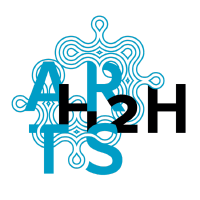LabEx Arts-H2H

The Laboratory of Excellence in Arts and Human Mediations
The Laboratory of Excellence in Arts and Human Mediations (Labex Arts-H2H) intends to link together artistic research (cinema, plastic arts, music, theatre, dance, literature, photography, new technologies) with research in cognitive sciences and human mediations. By exploring new connections between arts and techniques, science and reality, physical space and data space, the Labex Arts-H2H studies creative processes in their artistic, cultural and social dimensions and aims at imagining the world in its most creative and innovative forms.
The Laboratory of Excellence in Arts and Human Mediations is part of the “Investments for the future” program since 2011. As part of this program, its members conduct research following three main lines: situations, technologies, hybridization.
SITUATIONS
Through the dimension of sensitivity and perception, a reflection in action is performed: corporeal and psychological, intellectual and symbolic, its treasures of technique and imagination spread into the artistic field and extend to the social sphere. Recent developments in digital technologies now allow us to expand our thoughts concerning potentialities. Research focuses on how artistic and creative practices and their mediation function in the following areas:
Processes and functioning in creation: sensitivity and perception, behaviors, processes of appropriation, decision, action, composition; new forms of development and learning in arts and human mediations; art, critique and society; art and science; memory, creation, archives and collections.
Processes and functioning in creation: sensitivity and perception, behaviors, processes of appropriation, decision, action, composition; new forms of development and learning in arts and human mediations; art, critique and society; art and science; memory, creation, archives and collections.
TECHNOLOGIES
The wealth inherited from specific techniques, the work on sensitivity as it was constituted, the processes sedimented in a variety of disciplines remain essential to arts.
New technologies are, however, one of the factors that tend to transform the way art makes sensitivity perceptible. The evolution of the relations between players, creators, designers of artworks and the public is corollary of this transformation.
Research focuses on the consequences of this new digital configuration, in art and in the world. It may extend beyond the "digital sector" and develop in the field of the history of technologies: artistic devices and sensitive categories (sounds, images, texts); tools, concepts and artistic practices (art and environment, art and mobility, art and science); ergonomics, creation and human diversity (design, environments and adapted mediations).
New technologies are, however, one of the factors that tend to transform the way art makes sensitivity perceptible. The evolution of the relations between players, creators, designers of artworks and the public is corollary of this transformation.
Research focuses on the consequences of this new digital configuration, in art and in the world. It may extend beyond the "digital sector" and develop in the field of the history of technologies: artistic devices and sensitive categories (sounds, images, texts); tools, concepts and artistic practices (art and environment, art and mobility, art and science); ergonomics, creation and human diversity (design, environments and adapted mediations).
HYBRIDATIONS
Research focuses on the forms of hybridization in the history of arts, or on the impact the hybridizations have in the contemporary world:
Combination of arts (text and digital technology, opera and staging, dance and interactivity, performance and plastic arts).
Human / Technology (technologies and behaviors, technologies and representations, philosophy).
Combination of arts (text and digital technology, opera and staging, dance and interactivity, performance and plastic arts).
Human / Technology (technologies and behaviors, technologies and representations, philosophy).